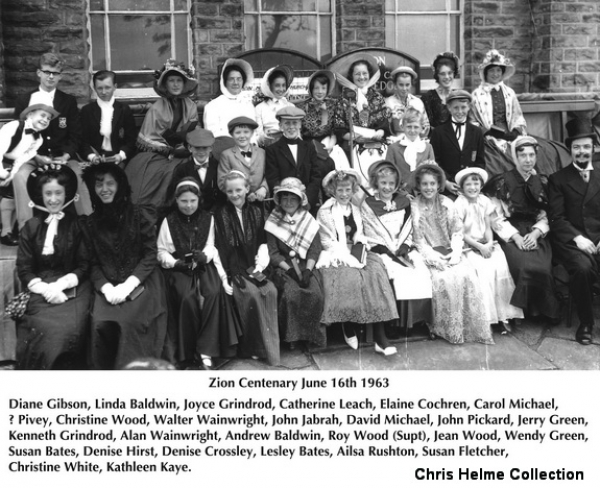Many small paperback histories of organisations have been produced by its enthusiastic and dedicated members. Over the years I have managed to collect, copy or buy at jumble Sales, car boot sales or at the local charity shop, a number of these small and very interesting publications.
One of these I bought through the internet a few years ago was the centenary booklet written by Peter Green to celebrate the 100 years of worship at the Zion Chapel at Hove Edge. Whilst some Hove Edger’s will not remember where the chapel was, many others will. For those of you who cannot remember, it was at the junction of Chapel Street and Spout House Lane.
Looking towards the end of the book the Zion held one of those bazaars that all chapels held to raise money. On this occasion it was towards the end of 1936 when they held a ‘Nautical Bazaar’, which lasted three full days. There was a specific reason for this event. In September of 1936 J.W. Drake sold the chapel a plot of land and numbers 11 and 13 Spout House Lane for the princely sum of £800 and this event was to help raise the money.
The bazaar stalls took the shape of ships and on the platform was a ships bridge and a large brass bell to attract the visitors attention when there were any announcements to make. Someone had created a large backcloth depicting the Queen Mary. Another novel idea was to build a stall around one of the pillars depicting an island and was filled with flowers and fruit.
One regular feature at most of these kinds of events was a fortune teller and here was no exception with the appearance of Madame Zazar, a well known Zion fortune teller. So popular was Madame Zazar that customers were queuing along each of the choir stalls. Although I don’t know how the raised, I’m sure it would have been a success and all who attended would have had a smashing time. Whether any of Madam Zazar’s premonitions brought her Zion customers any good fortune we will never know.
During the Second World War years Zion had to hold its evening services during the afternoon during the winter months because they had blacking out problems, which in turn affected the Sunday School afternoon sessions. Another potential problem was that the authorities informed the trustees that in the event of an emergency which had resulted from enemy action the chapel would be needed as a rest centre. In anticipation of this happening the emergency services took over one of the school rooms and used it as a storage facility for blankets and emergency supplies. They also insisted that ‘Anti-blast’ netting be placed over the schoolroom windows as a safety precaution. Something that left a visible stain on the windows for many years after it had been removed.
As more and more young men were called up for service Ernest Green and Leonard Collins felt it was their responsibility to try and keep in touch with all the lads that were away. The collection after each service was sent in to a Comforts’ Fund which enabled gifts to be sent to the Zion servicemen and women all over the world.
Some may remember the Young People’s Guild which was started during those war years by the Reverend J. W. Anderson and was later carried on by the Reverend Alan Webb. This was the earliest mention of what we would call today a Youth Club being held at Zion Chapel. This was carried on for many years after the war when even I remember visiting the Zion Youth Club and playing British Bulldogs.
Although the records show that only one soldier lost his life for his country few of the returning soldiers returned to play an active and full part in the fellowship of the chapel.
Looking through the names of trustees, it is clear to see that over the one hundred years written about in Peter Green’s fascinating account of this small church. Many members are from the same families and have been actively involved with it throughout those years.
The last chapter in the book is titled ‘The Future'. It highlights that times were difficult and money was one of the never ending problems. Little did they know then within almost twenty years the Zion Chapel, their spiritual home would be gone – demolished.
Whilst the buildings may have disappeared the memories of the countless fund raising efforts, youth club activities or stepping up to receive the Webster Shield (scripture examination) just as Jean Dale did in 1953, Philip Watkins did the following year and Lynda Baldwin did in 1960. Or a proud Joan Hardy did when she won the Collins Shield for her efforts in 1960.
No, this is not a fancy dress event for some local gala or garden fete. It is one of the events where members of the Zion Methodist Church at Hove Edge dressed in the style of clothes the local Hove Edge people would have dressed in to attend that special day in 1863. The year the very first Methodist church was started in the village.
Those bold enough to take part include: Diane Gibson, Linda Baldwin, Joyce Grindrod, Catherine Leach, Elaine Cockrem (please note this is the correct spelling unlike the spelling on the photograph), Carol Michael, Christine Wood, Walter Wainwright, John Tabrah, David Michael, John Pickard, Jerry green, Kenneth Grindrod, Alan Wainwright, Andrew Baldwin, Roy Wood (Superintendent), Jean wood, Wendy Green, Susan Bates, Denise Hirst, Denise Crossley, Lesley Bates, Ailsa Rushton, Susan Fletcher, Christine White and Kathleen Kaye.
The photograph was taken on a summers day in June 1963 - yes its 54 years ago....the group are sat outside the Zion Methodist Church at the corner of Chapel Street Hove edge. This church was opened in November 1882 and closed a century later and was later demolished for a new housing development.
Memories of happy days and fellowship at Zion will be remembered.
Chris





















